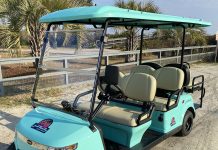
What to Look for in a Golf Cart Warranty
There are two ways to approach the topic of golf cart warranties. The first is simply to carefully study every model golf cart you can find and look up their records for longevity. How many out of 100 are still operating after ten or fifteen years? What is the typical breakdown history of the cart models you are considering for purchase? What is the average resale value of the golf carts you are considering?
Yes, that discussion might be considered the backstory for the warranty. Did you buy a great golf cart with a terrible warranty or a terrible golf cart with a great warranty? Obviously, you want to come out ahead on both the cart and the warranty. However, warranties are, at heart, in place for protection in favor of the consumer. Warranties protect the consumer from Manufacturer defects that can take place. An insurance policy is a completely separate topic that goes beyond a warranty to protect you from accidental scenarios and other issues that are out of the scope from a manufacturer. Overall, with either a warranty or an insurance policy, the best path forward is to avoid filing a claim all together. With warranties, winning is losing and losing is winning. The best warranty is owning a cart that never breaks down during its warranty period.
After finding a model with a great track record and high resale value, you then want to take each warranty you are offered and hold them up to the light. Compare each warranty line by line, because whether or not they are presented in a list form or not, warranties these days are itemized.
Together, let’s look at the basics of one typical, comprehensive warranty for Yamaha Golf Cars.
Example Golf Cart Warranty
YOU CAN VIEW YAMAHA GOLF CAR’S WARRANTY HERE.
The first thing to note is that this warranty is only good if you buy the cart from an authorized Yamaha dealer or directly from Yamaha. It’s called a “Four-year limited warranty” simply because it does not cover every possible contingency.
When looking at the itemized list, as well, you quickly see that many parts are not even warrantied for four years. The Frame, the pedals, electric wires, switches and relays, bumpers, bag carrier, windshield are only covered for three years, while the headlights and taillights are only covered for two.
No question about it, manufacturers do their research. They know the breakdown history of each part of their vehicles and the list tells you that windshields often suffer damage by their fourth year. So, they are only warrantied for three years. However, the companies also know that the big ticket items, namely the motor, needs to have an impressive warranty to be part of the cart’s selling points. So, the electric motor is covered for four years, as is the charger receptacle, charger cord and motor controller/charger.
Also covered for four years in the gas models are as follows: Exhaust, intake, generator, gas engine, throttle cables, clutch and brakes.
A standard feature of the warranties, as well, is what isn’t covered. This is the area that can lead to heated arguments when your golf cart breaks down. This list of warranty exemptions includes anything Yamaha considers “abnormal strain, neglect, abuse, including lack of proper maintenance and use contrary to the Owner’s Manual.”
Also not covered, problems associated with exposure, such as too many days under blazing sunshine. In addition, the company won’t cover anything that broke down if they find out the owner has made unauthorized modifications or alterations to the cart. Alterations can include anything from as simple as a custom seat to a lift kit. If you plan on making these alterations, then be sure to talk to your factory authorized dealer prior to doing so. The company also won’t cover problems that arose during transportation. If it’s in the back of some flatbed carrier or in the back of a pickup truck and something goes wrong, that’s on you.
Warranty on the Golf Cart’s Batteries
Of course, cart buyers will also be very interested in the warranty on the batteries for their electric golf carts, which can run into serious amounts of money if you have to pay to replace them yourself.
Yamaha’s battery warranty guarantees “36-hole performance” for four years or 23,500 amp-hours with one model (the T-875) and four years or 25,000 amp-hours with the T-875 batteries and the addition of a factory-installed Trojan HydroLink Battery Watering System, which takes away some of the guesswork in battery maintenance. Now this type of warranty structure has clearly been positioned to the use of the unit on a golf course, but not within a residential community. 36 holes equates to around 10 miles of use per day. With this logic, if you intend to use your golf cart for transportation inside a community, then it would be prudent to take a look at how far you intend to drive it on a daily basis. It would not take much to null out the warranty on batteries after 1 to 2 years.
Conclusion
This is not an endorsement; it is only to say that a comprehensive warranty should have comparable offerings as Yamaha’s.
In some shape or form, a warranty will name every part or every mechanical system of your golf cart either to say that certain items are covered while others are not.








